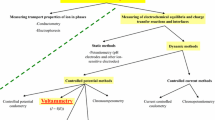Summary
Following the O-analyser, CH-analyser and N-analyser previously developed, an automatic CHN-analyser is described, based on the principle already used by Walisch. It involves a flash combustion of the sample in a stream of helium with 3% oxygen content, in a vertical reactor, the reduction of nitrogen oxides and removal of excess of oxygen by reduced copper, and the measurement of carbon dioxide, nitrogen and water by a thermal-conductivity cell. The signal from the detector is automatically integrated as a function of time and printed out. The analyser has been fully automated by the use of a vertical reactor, an automatic sample feeder and a collecting tube. This analyser makes possible the simultaneous determination of carbon, hydrogen and nitrogen in stable or unstable solid and liquid organic compounds within 13 min. The precision of results for sample weights in the range 0.2–0.5 mg has been shown to be equivalent to that obtained by Walisch.
Zusammenfassung
Nach den bisher entwickelten Geräten zur Sauerstoffbestimmung, zur C, H-Bestimmung und zur N-Bestimmung wurde nun ein Automat zur C, H- und N-Bestimmung auf der bereits von Walisch gewählten Grundlage ausgearbeitet. Er beruht auf der Blitzverbrennung der Einwaage in einem Heliumstrom mit 3% Sauerstoff in einem Senkrechtrohr, der Reduktion der N-Oxide und der Entfernung des Sauerstoffüberschusses mit Kupfer, der Messung des Kohlendioxids, des Stickstoffs und des Wassers in einer Wärmeleitfähigkeitszelle. Das Detektorsignal wird automatisch als Funktion der Zeit integriert und ausgedruckt. Das Gerät wurde vollautomatisiert durch Verwendung eines vertikalen Reaktors, einer automatischen Einwaagezufuhr und eines Sammelgefäßes. Mit diesem Gerät können C, H und N in stabilen oder instabilen, festen oder flüssigen organischen Verbindungen gleichzeitig in 13 min bestimmt werden. Die Genauigkeit der Resultate aus Einwaagen von 0,2–0,5 mg entspricht den Angaben von Walisch.
Similar content being viewed by others
References
D. Fraisse and R. Semet, to be published in Microchem. J.
D. Fraisse and R. Semet, Informations Chimie No.128, 201 (1974); D. Fraisse and B. Morin, to be published.
D. Fraisse and R. Andrianjafintrimo, Microchem. J.21, 178 (1976).
D. Fraisse and N. Schmitt, Microchem. J.22, 109 (1977).
W. Walisch, Chem. Ber.92, 2314 (1961).
J. Binkowski and R. Lévy, Bull. soc. chim. France10, 4289 (1968).
D. Fraisse and R. Richard, Microchem. J.21, 170 (1976).
B. Cousin and C. Muller, Talanta21, 1287 (1974).
Author information
Authors and Affiliations
Rights and permissions
About this article
Cite this article
Fraisse, D., Cousin, B. & Muller, C. Automatic microanalysers—V. Mikrochim Acta 70, 9–21 (1978). https://doi.org/10.1007/BF01196464
Received:
Issue Date:
DOI: https://doi.org/10.1007/BF01196464




